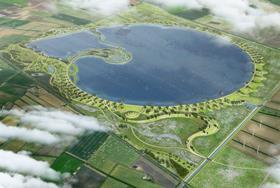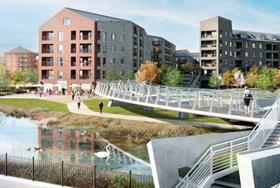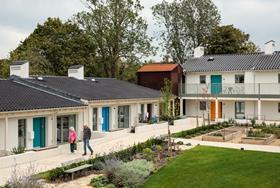Government fast-tracks LDA Design and Fereday Pollard-designed reservoirs in Cambridgeshire and Lincolnshire
Schemes designated ‘nationally significant’ as part of wider efforts to unlock housing growth and address long-term infrastructure shortfalls
Source: LDA DesignA rendering of the proposed new Lincolnshire reservoir
Two new reservoir projects proposed by Anglian Water and Cambridge Water have been awarded nationally significant infrastructure status, with the government stepping in to fast-track the planning process amid growing concern about the impact of water shortages on housing and economic development.
The reservoirs, located near March in Cambridgeshire and south of Sleaford in Lincolnshire, are now set to bypass the local decision-making process and will be determined directly by Steve Read, the environment secretary. The intervention forms part of the government’s broader “plan for change”, which seeks to accelerate the delivery of 150 major infrastructure projects and support the construction of 1.5 million new homes by the end of the current parliament.
Design proposals, developed by LDA Design and Fereday Pollard, include sculpted embankments formed from excavated soil, integrated wetland habitats and publicly accessible routes intended to support recreation and biodiversity.
According to government figures, the Fens Reservoir is expected to supply around 87 million litres of water per day to 250,000 homes when completed in 2036. The Lincolnshire Reservoir would deliver up to 166 million litres per day for as many as 500,000 homes, with an anticipated completion date of 2040.
The Department for the Environment, Food and Rural Affairssaid the decision to intervene reflects the urgency of addressing regional water stress. “Today we are backing the builders not the blockers, intervening in the national interest and slashing red tape to make the planning process faster to unblock nine new reservoirs,” said water minister Emma Hardy.
“This government will secure our water supply for future generations and unlock the building of thousands of homes as part of the plan for change.”
Source: LDA DesignA rendering of the proposed new Fens reservoir
The reservoirs are being brought forward against a backdrop of strained infrastructure capacity and an extended period without new large-scale water storage projects. No major reservoirs have been delivered in England since 1992.
According to the government, the combination of population growth, ageing infrastructure and climate change has created “a significant risk that the UK could run out of clean drinking water by the middle of the next decade”.
Water scarcity has already delayed housing development in parts of the east of England and South-east, including in Cambridge and north Sussex. The government has said that the Fens and Lincolnshire reservoirs will help to address these blockages by providing the baseline infrastructure needed for new homes to proceed.
David Black, chief executive of Ofwat, said: “We welcome the clear focus the government is placing upon accelerating the delivery of supply and resilience schemes that will meet our future water needs and support economic growth. Alongside the £2bn of development funding announced at our 2024 price review, this will help us to deliver the largest programme of major water infrastructure projects seen in decades.”
The Cambridgeshire and Lincolnshire schemes are two of nine reservoirs across England that water companies have committed to deliver by 2050. Together, they are expected to add 670 million litres per day to the national supply.
#government #fasttracks #lda #design #fereday
Government fast-tracks LDA Design and Fereday Pollard-designed reservoirs in Cambridgeshire and Lincolnshire
Schemes designated ‘nationally significant’ as part of wider efforts to unlock housing growth and address long-term infrastructure shortfalls
Source: LDA DesignA rendering of the proposed new Lincolnshire reservoir
Two new reservoir projects proposed by Anglian Water and Cambridge Water have been awarded nationally significant infrastructure status, with the government stepping in to fast-track the planning process amid growing concern about the impact of water shortages on housing and economic development.
The reservoirs, located near March in Cambridgeshire and south of Sleaford in Lincolnshire, are now set to bypass the local decision-making process and will be determined directly by Steve Read, the environment secretary. The intervention forms part of the government’s broader “plan for change”, which seeks to accelerate the delivery of 150 major infrastructure projects and support the construction of 1.5 million new homes by the end of the current parliament.
Design proposals, developed by LDA Design and Fereday Pollard, include sculpted embankments formed from excavated soil, integrated wetland habitats and publicly accessible routes intended to support recreation and biodiversity.
According to government figures, the Fens Reservoir is expected to supply around 87 million litres of water per day to 250,000 homes when completed in 2036. The Lincolnshire Reservoir would deliver up to 166 million litres per day for as many as 500,000 homes, with an anticipated completion date of 2040.
The Department for the Environment, Food and Rural Affairssaid the decision to intervene reflects the urgency of addressing regional water stress. “Today we are backing the builders not the blockers, intervening in the national interest and slashing red tape to make the planning process faster to unblock nine new reservoirs,” said water minister Emma Hardy.
“This government will secure our water supply for future generations and unlock the building of thousands of homes as part of the plan for change.”
Source: LDA DesignA rendering of the proposed new Fens reservoir
The reservoirs are being brought forward against a backdrop of strained infrastructure capacity and an extended period without new large-scale water storage projects. No major reservoirs have been delivered in England since 1992.
According to the government, the combination of population growth, ageing infrastructure and climate change has created “a significant risk that the UK could run out of clean drinking water by the middle of the next decade”.
Water scarcity has already delayed housing development in parts of the east of England and South-east, including in Cambridge and north Sussex. The government has said that the Fens and Lincolnshire reservoirs will help to address these blockages by providing the baseline infrastructure needed for new homes to proceed.
David Black, chief executive of Ofwat, said: “We welcome the clear focus the government is placing upon accelerating the delivery of supply and resilience schemes that will meet our future water needs and support economic growth. Alongside the £2bn of development funding announced at our 2024 price review, this will help us to deliver the largest programme of major water infrastructure projects seen in decades.”
The Cambridgeshire and Lincolnshire schemes are two of nine reservoirs across England that water companies have committed to deliver by 2050. Together, they are expected to add 670 million litres per day to the national supply.
#government #fasttracks #lda #design #fereday
0 Commentarios
0 Acciones






